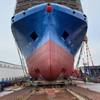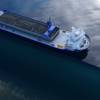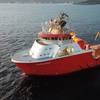Prof. Matti Kleimola, Chief Technology Officer (CTO) for Wärtsilä Corporation, was recently elected as President of CIMAC. He is a member of Wärtsilä Board of Management, Technology and Environment, and Head of Corporate Technology, including R&D. MR took a few moments to discuss with him emerging trends in the marine propulsion market.
Q What is your area of responsibility as the new president of CIMAC.
A The aim of CIMAC is to promote exchange of technical and scientific knowledge, to improve understanding between manufacturers, users and suppliers, to promote the work and activities of national associations in the field of combustion engines technology (piston engines and gas turbines) in marine/ship propulsion, power generation, rail traction and industrial applications. The President is the chief officer of CIMAC and presides over meetings of the CIMAC Council and the CIMAC Board. The President is elected by the Council at the meeting held during the period of the Congresses and is selected from present or past Vice-Presidents. CIMAC Board has a responsibility for the provision of management direction. The Council consists of representatives from the NMAs, NMGs and CMs and is responsible for the technical, financial and administrative policy of CIMAC.
Q Briefly discuss the importance of CIMAC in the advancement of propulsion technologies.
A CIMAC provides a forum for technical interchange with all parties concerned with piston engines and gas turbines. The organization promotes the development of combustion engines and their applications. Congresses are held every three years and that activity has been ranked very important and valuable for delegates (engine manufacturers, users, scientists etc.). The Working Groups are established by the Council to prepare recommendations and actual reports on subjects of combustion engine technologies. Some examples of working areas will be: Emissions, Fuels, Automation, Classification, Lubrication, Users etc. The activity will give direct benefits to manufacturers and engine users.
Q What are the top three or four issues that have, in your opinion, had the most significant impact in driving marine propulsion development?
A 1. The rising fuel oil prises during 70's and 80's speeded up the engine efficiency development and development of heavy fuel engines dramatically;
2. Ship sizes have shown a tendency for tremendous growth and that has created the market for largest two-strokers and trend is continuing;
3. Customer need for smokeless operation in cruise business initiated the fast development of 4-stroke common rail engines;
4. The emission legislation has been one of the main driver to develop clean engines.
Q What technologies do you count as having the most significant positive impact on marine propulsion in the last decade?
A Focus on the environment has encouraged the development of novel technologies for fuel injection and combustion development. Electronic control systems will become standard and the common rail technology is optimized for new two-stroke and four-stroke engines. The common rail technology has established clear performance benefits for ship-owners like smokeless operation, reduced fuel consumption, lower noise and lower, stable running speeds.
The engine industry will work actively to develop products of modern design in order to comply with the increasing demand for reduced emissions. Additional devices and processes are needed to reduce NOx emissions. The introduction of Miller cycle was very efficient in decreasing the NOx content of exhaust gases and that technology has been implemented widely. The CASS and HAM technologies and Direct Water Injection, where water is added into the intake until the air is saturated or into combustion chamber, have been found very efficient by reducing NOx emissions.
The anti polishing ring technology efficiently removes any onsets of deposits formation from the piston top land. The technology will reduce dramatically the wear of cylinder liner and piston rings and prolong the life time of components. The solution has been implemented in modern heavy fuel engines.
Q In comparing marine propulsion to other markets, what are the challenges unique to this business?
A Shipyards around the world will concentrate on their core know-how and business. This is the result of tough competition, because there is more shipbuilding capacity than demand for new tonnage. There is a clear demand from shipyards for partners who can provide complete functional systems. Ship-owners are also increasingly asking for long-term relationships with their main suppliers. The suppliers must cover the full range of systems on board. The partnership requested includes everything from advice on the optimal solutions for a specific ship business concept to maintenance and service throughout the lifetime of the ship in all over the world. This means that strong presence, confidence and responsibility are crucial factors for a long-range partnership.
Q What do you consider to be the top challenges facing the marine propulsion industry?
A Our long term investigations through year 2030 show that reciprocating engines will continue to dominate with more than 90 percent of all vehicles on land and at sea. There is no other prime mover technology that could override piston engines in marine use. The success of diesel engines is based on very good efficiency and the ability to burn fuel of poor and high quality. The big challenge will be to comply with the continuous trend to reduce the exhaust emission. The fact is that in the coming decades more than 80 percent of energy needed in the world will continue to be based on conventional fossil fuels like oil, gas and coal.
Q How is Wartsila preparing now to meet those challenges?
A Wärtsilä Corporation is a leading supplier of machineries and total ship-power packages for our customers. We have a strong network service outlets and offices in more than 60 countries throughout the world. We will continue to bring new products and new technologies to the market while at the same time improve performance of the old ones. We are also a leading supplier of common rail engines, both 2-stroke and 4-stroke. Wärtsilä has good know-how and resources to develop engines to comply future emission standards and outstanding performance. In addition to that we can offer the first-class service for our customers in all over the world.
Featured videos

Inmarsat Enhances Service to Drive Digitalization

Tracking Foreign Vessels Working in the U.S. Jones Act Market

Unlock Onboard Data Efficiencies
Subscribe for
Maritime Reporter E-News
Maritime Reporter E-News is the maritime industry's largest circulation and most authoritative ENews Service, delivered to your Email five times per week









